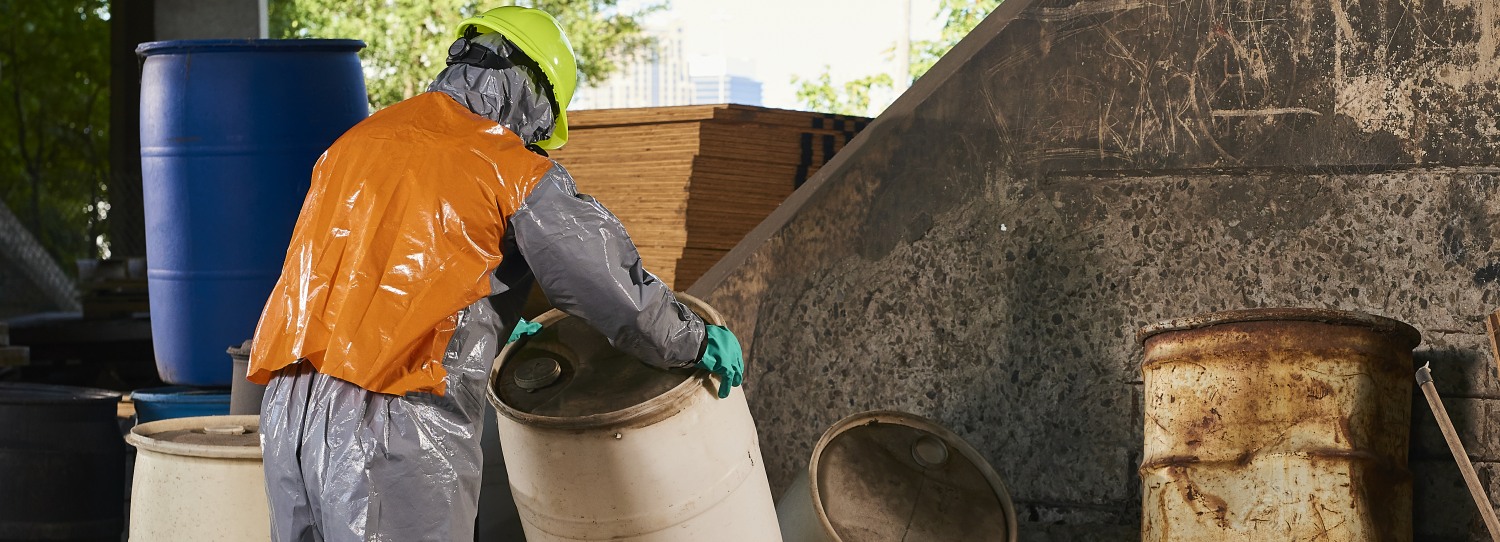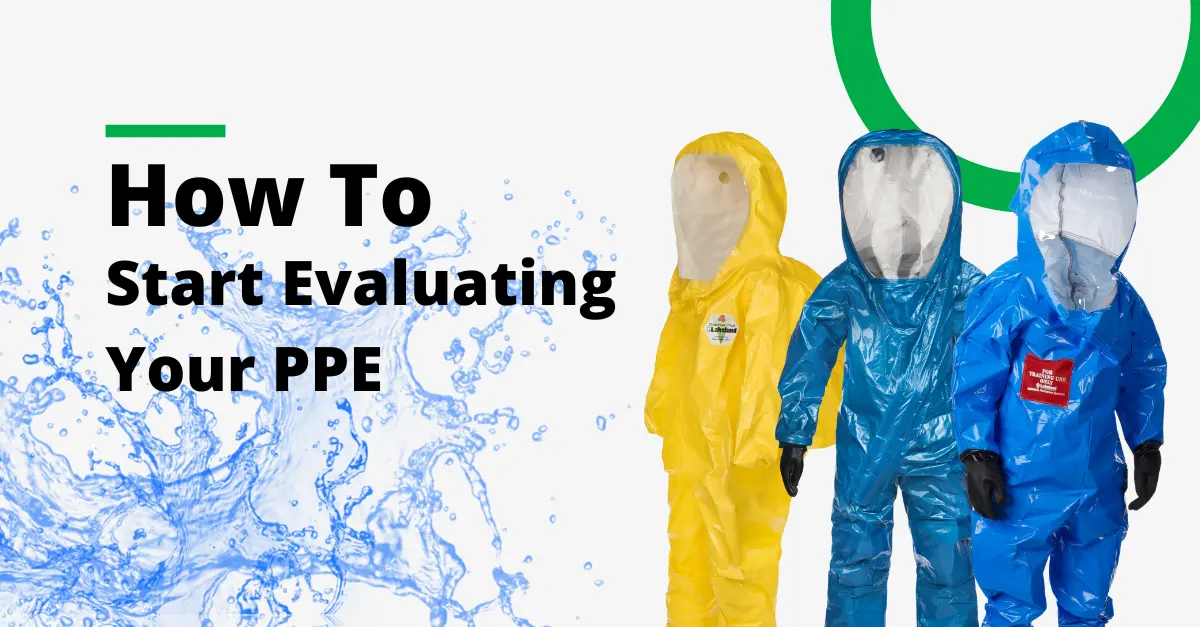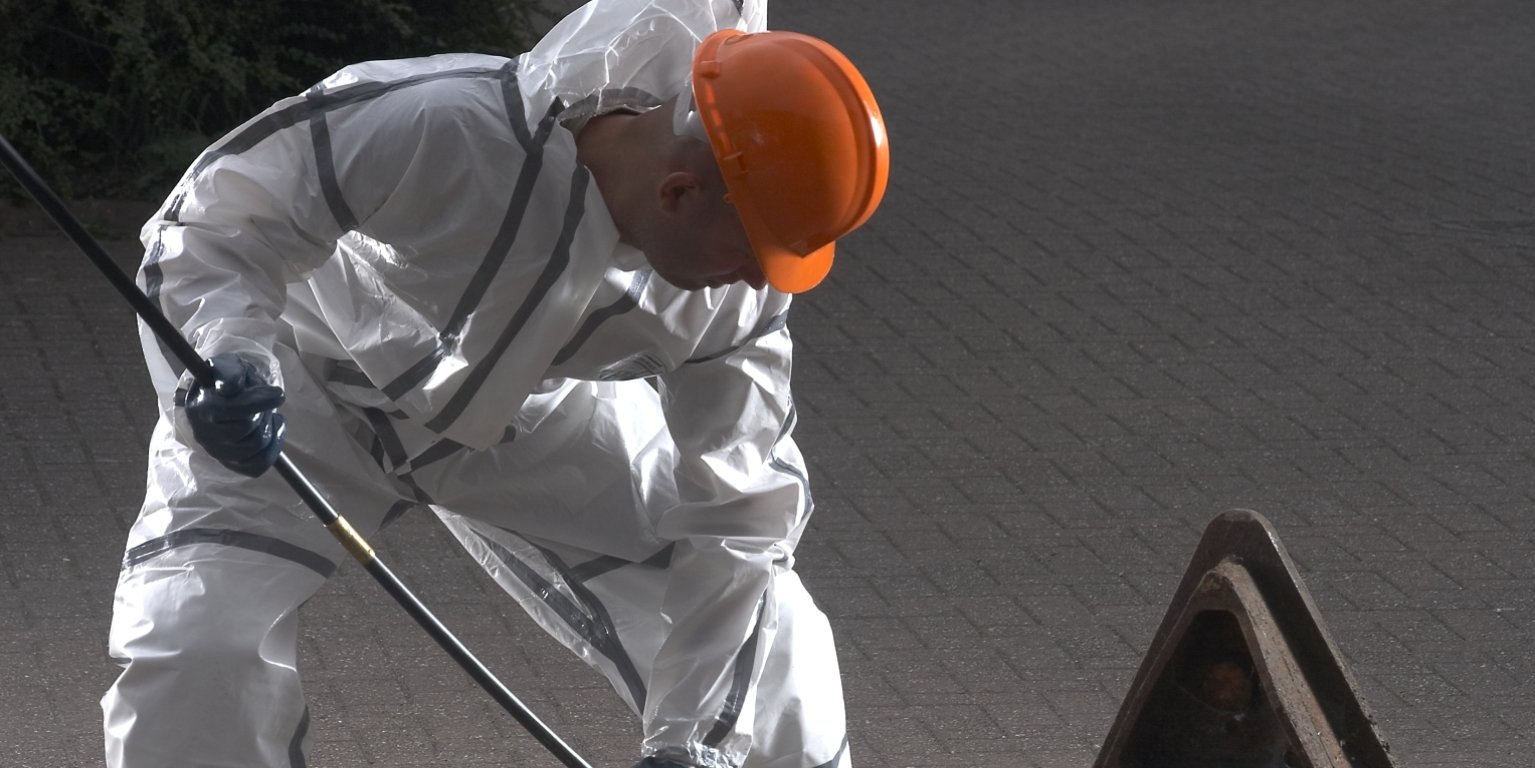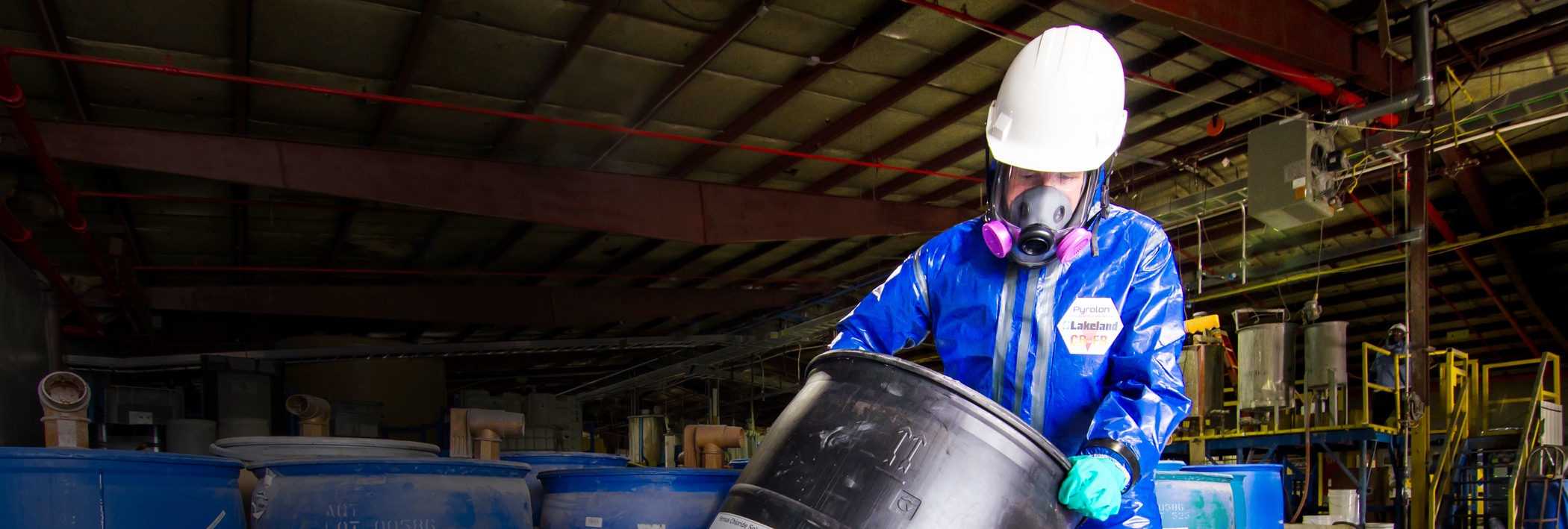ChemMax®: Designed to Achieve the Optimum Combination of Protection, Comfort and Durability.
Ensuring workers are protected against the insidious nature of many chemicals when contamination may barely be noticed yet long-term health consequences catastrophic is a complex business. Meanwhile, the choice of available garments in the market has ballooned in the last two decades with a bewildering array of multiple brands and types promoted by a range of PPE manufacturers and distributors.
Lakeland’s ChemMax® range of clothing to protect against chemical hazards in the workplace provides a comprehensive spread of protection, durability, comfort, and design to meet the needs of most applications, and all backed by Lakeland’s decades of experience, expertise, and passion for protection. This blog considers the requirements for consideration in selecting your ideal chemical suit and how ChemMax® meets those needs.
Running short on time? Download a PDF with this information now!
Jump to various sections of this blog by clicking below:
Finding the right PPE of any type to offer the right level of protection for each operator and task is a fundamental yet challenging aspect of a Safety Manager’s remit. When it comes to chemical safety, multiple and often conflicting decision drivers must be considered: –
- Ensuring adequate protection remains paramount, whilst not over-protecting and thus spending more than you need from an already tight budget.
- Maximizing comfort without compromising safety so that an effective level of comfort is achieved for workers.
- Achieving the protection-comfort balance that helps ensure workers will actually wear the PPE properly (comfort is safety issue).
- Ensuring PPE will not adversely affect productivity.
- Ensuring compatibility with other PPE.
- Establishing effective training programs to ensure proper use.
- Installing care and maintenance programs to ensure the PPE remains fully capable of protecting as long as it is used.
The list is almost endless. It’s quite a challenge for the safety manager.
The Trinity of Chemical Suit Selection: Protection, Durability & Comfort
Choice of a chemical suit revolves around the three key issues of protection, durability, and comfort. The trick is to identify the “sweet spot,” the compromise between each that is perfect for your application. This blog analysis each of these in three separate sections: –
Section 1: Protection
Effective protection from hazardous chemicals in the workplace requires an understanding of the distinction between permeation and penetration, the routes by which dust, liquid, and gaseous chemicals can enter inside the garment or PPE ensemble and contaminate the worker. They are two distinct processes explained in the video below:
Penetration is the process by which a liquid, dust, or gas will pass through holes or gaps in the garment fabric or construction. It can only occur if there are physical gaps to pass through such as: –
- Gaps between the fibers in a woven fabric such as in SMS coveralls.
- Gaps in the garment construction such as the stitch holes in the seams or between the teeth or the tape weave in the zipper.
- Gaps between the chemical suit and other PPE such as face mask, gloves, and boots.
Permeation is the process by which a chemical will pass through a “solid” barrier film at a molecular level when the molecules of the chemical pass between the molecules of the barrier polymer. It is a process that is inevitable and cannot be prevented, only delayed or slowed. Permeation might also occur without any visible indication; it can take place with no discernible effect on the fabric, so you might not be aware it is happening.
In an assessment of any chemical suit, therefor, it is important to remember these key points:-
- Effectiveness of permeation resistance is defined by the polymer(s) in the barrier fabric of the suit. It is garment FABRIC choice that protects against PERMEATION.
Permeation occurs in very small volumes, measured in micrograms (a microgram being 1 millionth or 0.000,001 of a gram). It is therefor only really relevant for chemicals that are harmful in very small quantities, those where the high toxicity can result in long term conditions such as cancers and damage to organs Effectiveness of penetration resistance is defined by the construction and design of the suit and how effectively it coordinates with other PPE such as face-mask, gloves, and boots. It is therefor, garment DESIGN and FEATURES that ensure protection against PENETRATION through possible holes in the PPE ensemble.
Penetration generally occurs in much larger volumes than in permeation, so it is more relevant for those chemicals that are harmful in larger volumes – those such as acids that cause burns or solvents that will result in dermal irritation.
It is also worth considering that given a reasonable barrier to permeation by the fabric, the far greater likelihood is that penetration will occur through holes and gaps in the PPE ensemble.
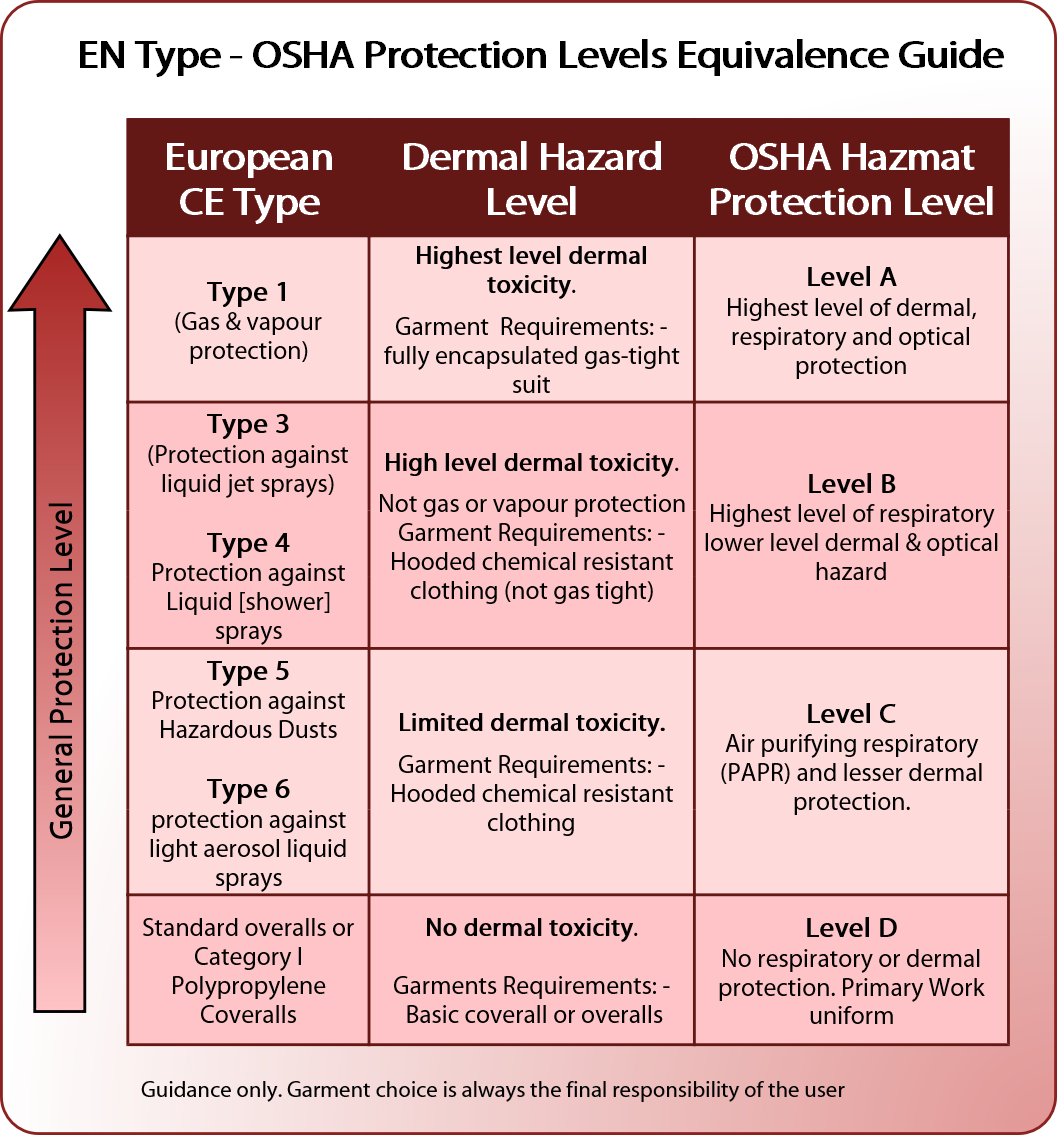
Resistance to Permeation of Hazardous Substances
Different polymers are used to provide protection against permeation of different chemicals. Chemical suits for Types 1, 3, and 4 applications (or level A and B suits in North America) generally use solid, barrier films with a level of permeation resistance. For resistance to a wider range of chemicals, or more challenging chemicals, several layers of specialized polymer films may be used, such as in the multiple layers in ChemMax® 3, 4, Plus and Interceptor Plus fabrics.
|
Not all Type 3 & 4 garments are made of impermeable barrier film. Type 6 garments generally deal with less hazardous chemicals and are often constructed with permeable fabrics – not solid barrier films. However, in some cases, fabrics normally used for Type 5 and 6 (or Level C to D garments in North America) are also certified as Type 4 if made with sealed seams. The “Type Tests” used for the EN clothing Types (Types, 3, 4, 5, and 6 and so on – see below) assess garment design to identify penetration, not permeation resistance, so a fabric normally used for Type 6 can pass a Type 4 penetration test if constructed appropriately. This does not, however, mean it is an effective barrier against permeation. |
Different polymers will resist permeation of different chemicals more or less effectively. Polyethylene is a standard, basic polymer film that provides a good general barrier against a broad range of less challenging chemicals and is usually the single layer choice for entry-level EN Type 3 or 4 or OSHA level A and B suits (such as ChemMax® 1).
Fabrics that resist permeation of more challenging or dangerous chemicals, or provide protection against a wider range of chemicals, consist of multiple film layers and are consequently heavier and less comfortable.
Thus, understanding the chemical, its nature, and its toxicity (i.e., the amount of it required to cause harm) is an important first step in chemical suit selection.
Measuring Resistance to Permeation of Hazardous Chemicals
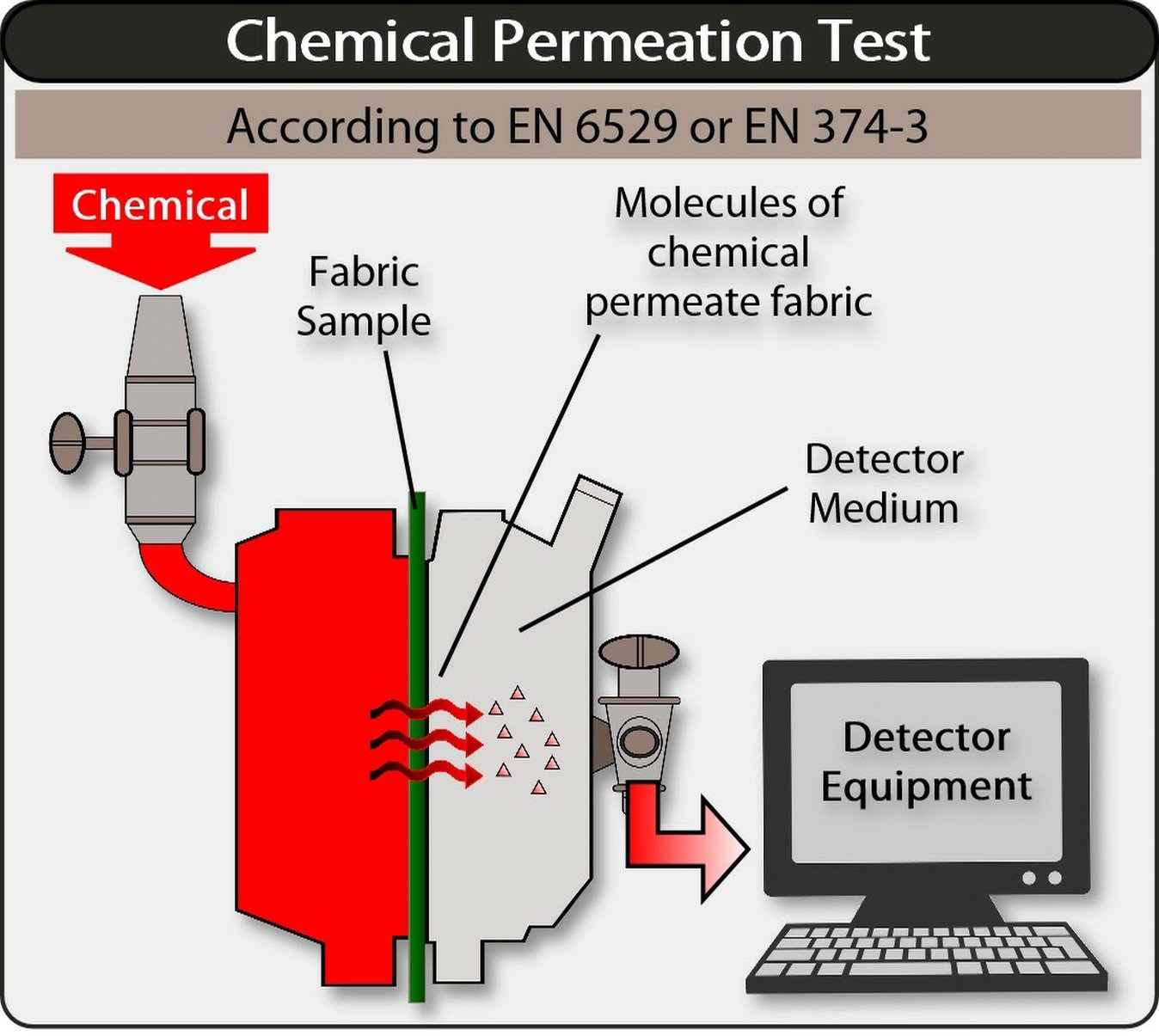
But beware! The “breakthrough” in this test is not when the chemical first “breaks through” the fabric, as many users believe. In fact, it is defined as the time until the RATE of permeation through the fabric reaches a specific speed and so is not an indication either of how long you can safely wear the suit or even that you are safe wearing it. Safe-wear assessment will depend on the volume permeated over time and on the individual dermal toxicity limit of the chemical. Permeation test results should primarily be used for performance comparison of different fabrics – to identify if one suit fabric is better than another and not as an indication of safe-wear.
This misinterpretation of the permeation test result is one of the most common in PPE, and if not understood correctly, could result in workers believing they are better protected than they really are. You can discover more about the correct interpretation of permeation tests and how to calculate safe-wear times here.
| A key difference between the European and US Permeation Test. |
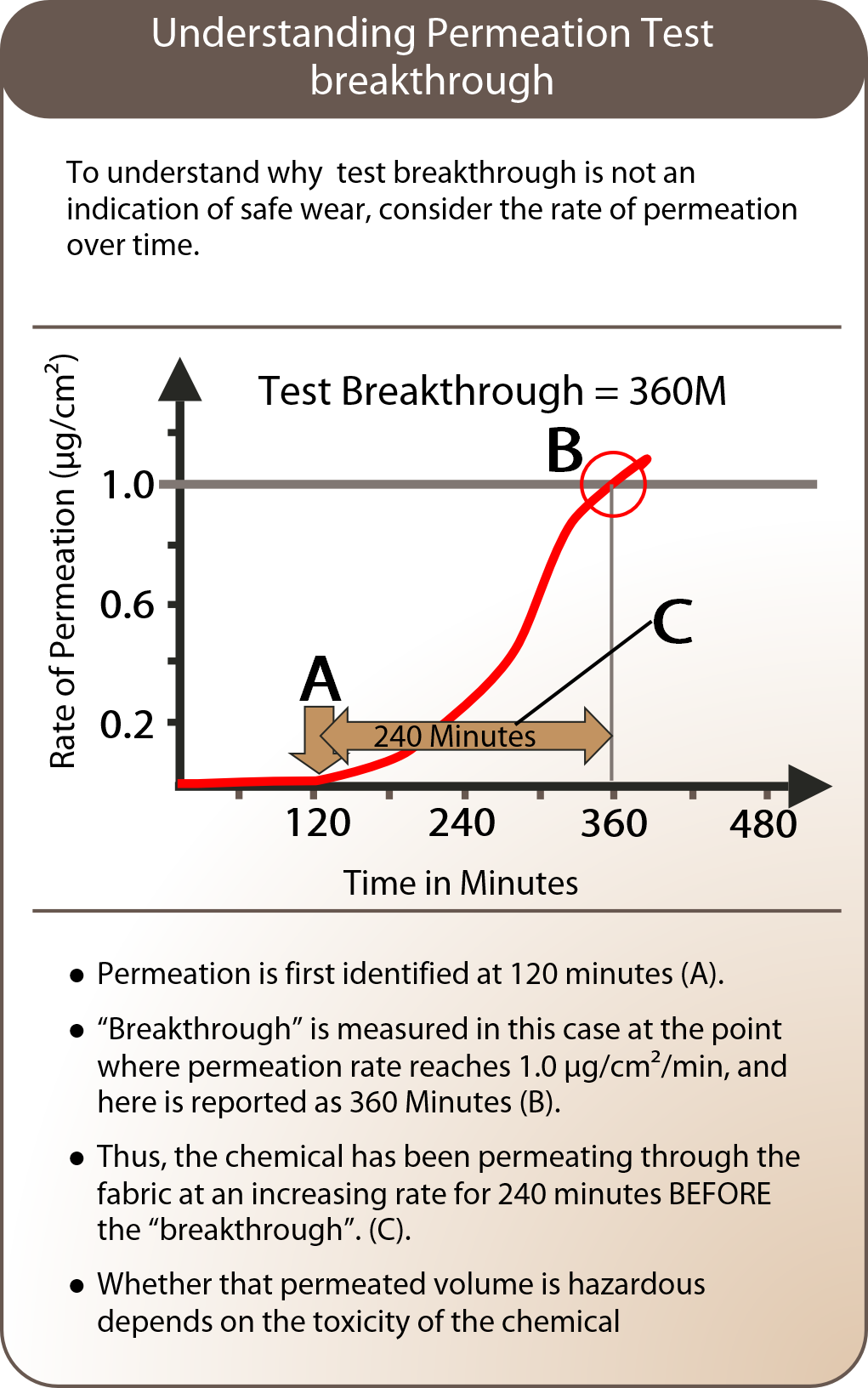
In Europe, the permeation test EN 6529 defines the “breakthrough” or “normalized breakthrough” as the time until the RATE of permeation reaches EITHER 1.0 OR 0.1µg/cm2/min, but in general the 1.0µg figure is used for historical reasons. In North America, the equivalent ASTM F739 test specifies breakthrough as the time until the RATE of permeation reaches 0.1µg/cm2/min. Importantly, the fact that the breakthrough is the time until a speed of permeation is reached means that the chemical has been permeation through the fabric before the “breakthrough”, at an increasing rate until it reaches whichever threshold is used. Neither, of course, indicates when the chemical first breaks through the fabric nor that you are safe. However, when looking at permeation test data for comparison purposes it is important to confirm that the same normalized breakthrough is being used. |
Permeation Resistance Summary
In conclusion, when considering the choice of chemical suit for a specific application in terms of permeation resistance, the important points are: –
- Permeation occurs at a molecular level through barrier films and is primarily a consideration with chemicals that are harmful in very small volumes, such as those that may cause cancers or organ damage over time.
- Permeation Resistance of a chemical suit relates to the fabric and the layers of polymers used in its construction.
- Permeation resistance is assessed through the use of the permeation test (EN 6529 or ASTM F739)
- However, the permeation test should only be used for comparisons of permeation resistance of different fabrics and not interpreted as an indication that a suit is safe to wear.
- Assessment of safe-wear should be made using knowledge of volume permeated over time and the dermal toxicity limits of the specific chemical.
| ChemMax® Guidance |
|
How does ChemMax® address Permeation Resistance? |
|
|
Resistance to Penetration of Chemicals
A chemical cannot penetrate through the solid barrier film of a suit fabric – there are no holes through which it can pass (unless the fabric becomes heavily abraded or torn). It could, however, penetrate (in considerably larger volumes than if it permeates through fabric) through any holes or gaps in the garment construction (seam holes or zipper teeth), or through gaps between the garment and other PPE (such as gloves, boots, or face mask).
Thus, whereas fabric choice relates to resistance against permeation of a specific chemical, protection against penetration is dealt with by the garment design and features such as the use of sealed seams to remove the risk of stitch holes, and an effective front fastening to ensure no liquid can pass through the zip.
Resistance to penetration can only be addressed by tests conducted on the whole garment – not just the fabric. In EN standards these are referred to as “Type Tests”, with standards defining five different protection types relating to the form of protection:
- Dust (Type 5), Liquid (Type 3,4 and 6) or gas (Type 1), and for liquid protection: –
- Light Aerosol Spray (Type 6), Shower-type spray (Type 4), and pressurized jet Spray (Type 3)
In North America, specific garment “Types” are not defined, and there are no equivalent tests conducted on whole garments. However, OSHA (Occupational Safety & Health Administration) defines four hazmat levels of protection (A, B , C, and D) relating to the type of hazard presented by the chemical. A difference between the approach in North America and in Europe is that the former focuses on applications and/or hazards whereas EN standards focus on products. So whereas in Europe, each product used for chemical protection (clothing, face masks, gloves, boots, etc.) is dealt with by a different standard, the approach of OSHA in North America is to identify different protection levels and define in general terms all the PPE required, including clothing, respirators, gloves and boots.
Furthermore, the OSHA levels treat respiratory hazards as the primary concern with dermal hazards being secondary. EN chemical suit Types consider only dermal hazards, with respiratory hazard PPE being dealt with be separate standards
For these reasons, it is difficult to identify a direct correlation between the EN Types and the US protection levels purely for chemical protective clothing. However, the table below outlines a broad comparison, though we would stress this is in general terms only.
Testing of EN Types are described briefly below. There is no comparable testing for protection levels in North America
Testing Resistance to Penetration.

Garments for protection against gases and vapors are suits that are completely sealed against ingress from outside the suit, the wearer obtaining breathing air either through an SCBA worn inside it or via an air supply line passing through the skin of the suit to a breathing mask. They are tested primarily through the use of an inflation pressure test (defined in EN 17491-1:2012). This involves inflating the suit to a specific pressure then confirming that over a specified period, the pressure does not reduce by more than the allowable change defined in the test. It is thus measuring the air-tightness of the suit, proving that as air cannot escape the suit, a gas cannot penetrate inside it.



The principle for all these tests is as follows: –
- A test subject dons the test suit and performs a series of exercises designed to replicate the normal stresses of a working environment.
- The subject enters a spray cabin.
- The subject is subjected to either different types of liquid spray or (in the case of Type 5) the cabin is filled with dust particles for a specified period.
- The test subject emerges from the cabin, and an assessment is made of any penetration of dust or liquid inside the suit with a pass or fail according to specific criteria.
Thus, the Type tests are a simulation of a working environment where a suit might be challenged by a chemical in different formats. They provide not only an indication of the penetration resistance of the suit construction, but also, of how effectively the suit works with other PPE.
However, care needs to be taken when interpreting the results and any assumptions about the levels of protection they indicate for two reasons: –
- The pass criteria do allow for some minimal penetration in all of the three liquid spray tests and the dust test. This might be important for chemicals with high level toxicity where a small amount of penetration could matter.
- In most cases when testing, additional tape is used to seal joins between hood and face mask, and sleeves and gloves to prevent penetration at these junctions that could result in a fail. Thus, in the real world a suit that is NOT taped in this way will not necessarily perform as indicated by the Type test.
|
ChemMax Guidance |
|
Type Testing and Construction of ChemMax Chemical Protective Clothing |
Design and ConstructionAll CE certified ChemMax® are certified to Types 3, 4, 5, and 6. All feature stitched and taped seams to remove the possibility of penetration through seam holes. Garment front fastenings feature a double zip and double storm flap for secure protection at the front of the garment, generally the most critical area. In addition, in-built cushioned, double-layer knee-pads improves comfort and protection when users must kneel or crawl. Super-B Style Lakeland has developed a unique garment style with several key features: – Hoods use a unique three-panel hood with a shaped center panel, creating a more rounded shape. Not only does this fit better to most face masks, it also moves better with the head, allowing more consistent visibility as the wearer moves. Inset Sleeves, (rather than the more traditional and cheaper “bat-wing” style) means better fit and comfort, allowing more freedom of movement, reducing stress at the crotch, and minimizing pull back at the cuffs when reaching. The video below shows the effect of this compared with a competitor garment. Finally, the addition of a two piece gusset in the crotch creates a more 3D shape, enhancing fit and freedom of movement and minimizing stress at the crotch – often the weakest point in most garments. For sealing the join between sleeve and gloves, ChemMax® garments can be used in conjunction with the Push-Lock glove connection system. A simple, re-usable set of plastic rings which allows a strong and secure, Type 3 jet tested method of attaching gloves to a ChemMax® garment. You can discover more about the Super-B style and the design elements and features of ChemMax® by downloading our free fact sheet. |
Section 1: Protection Summary
ChemMax® clothing to protect against hazardous chemicals in the workplace focuses on three ways to protect workers more effectively.
- Choice of fabrics to provide a wide range of permeation resistance, backed with extensive permeation testing and tools such as Permasure® to calculate safe-wear times.
- Unique design in the Super-style that improves how the garment works with other PPE such as reducing pull-back at the sleeves and reducing stress at the crotch.
- A range of features such as stitched and taped seams, a double zip and storm flap, and cushioned, two-layer knee-pads.
Section 2: Durability
The question of single- or multiple-use of chemical suits is an important question. Whilst there is no absolute definition of what constitutes either, in specific circumstances, (if it is remains undamaged, uncontaminated and functional) any chemical clothing can be re-used.
Durability of a suit however is important for two reasons: –
- If a suit is weak and becomes damaged during the work task it will fail to protect the wearer. Poor durability is a hazard.
- If conditions allow re-use of garments, it is self-evident that a garment with poor durability will offer limited options.
| Re-use of any chemical suit, whether classed as single-use or re-usable, should only be done in specific circumstances, with suitable controls in place and following an effective risk assessment. Re-use of chemical protective garments is always a risk. You can read more about this here. |
Durability is a function of three aspects of the garment: –
- The fabric strength properties
- The construction (seam) strength
- An ergonomic garment design
Fabric Strength Properties
CE standards offer a specific list of strength tests with results classified according to defined classification tables to allow easy comparison of different garments. These include abrasion resistance, tensile strength, trapezoidal tear strength, puncture resistance, and flex-cracking resistance.
Standard testing used in North America provides a range of similar fabric profile tests allowing comparison of garments, though using test results rather than classifications.
Construction (Seam) Strength
CE standards also require a test on the strength of the garment seam (similar to a simple tensile strength but with the sample including a seam) and with results classified for easy comparison. Seam strength results can also be found in datasheets and in our Guide to Chemical Suit Selection.
|
ChemMAx Guide |
|
How do ChemMax® garments deal with durability requirements? |
|
All Lakeland CE certified garments are constructed with stitched and taped seams, as shown in the image. These are intrinsically stronger than alternatives such as ultrasonically welded seams used on some garments from other manufacturers, which suffer from weakness along the seam, even though tensile strength may appear acceptable. Welded seams can also suffer from hairline cracks where excessive power or pressure has been used on a seam, problems that may not be visibly apparent. In North America ChemMax® garments are available in a choice of serged (stitched), bound or stitched, and taped seams, according to the needs of the application. |
Section 3: Comfort
The level of comfort offered by a chemical suit is limited for obvious reasons; comfort is primarily a function of fabric breathability or air permeability, and fabrics featuring an effective barrier to chemical permeation cannot feature any level of real air permeability. Thus chemical suits are inevitably uncomfortable to wear.
On the other hand, there are great benefits if comfort can be enhanced – benefits that can transfer directly to the business’s bottom line. Faster working and improved productivity, longer work periods and fewer breaks, better morale, and so on.
Whilst comfort is primarily a function of fabric breathability other factors can influence and enhance it… or at least, can reduce the level of discomfort: –
- Fabric weight and flexibility
Lighter weight and more flexible fabric result in greater comfort, so selecting the right fabric and not using heavier chemical suits than needed can help.
- Garment design and size
A more ergonomically designed suit combined with the correct choice of size will improve freedom of movement, reducing tightening and pulling, and generally enhancing comfort.
- Identifying the application properly to allow selection of more comfortable designs.
Understanding the difference between different Types can mean a more effective choice of garment. The best example is in the differences between Type 3 and 4 chemical suits.
Most suits on the market designed for protection against hazardous liquid chemicals are certified to both Type 3 and 4, despite being two distinct types of protection. Failing to distinguish between the two and to determine whether you have a Type 4 rather than a Type 3 application may represent a missed opportunity for safety managers to adjust that “sweet spot” within the trinity of protection, comfort and durability, by moving the choice more in favor of comfort without compromising safety.
A specifically Type 4 application, (and we estimate over 75% of applications are Type 4 and not Type 3) allows more comfortable options, such as Lakeland ChemMax® Cool Suits. These feature a design allowing air in and out of the coverall through a protected breathable rear panel, which allows effective Type 4 protection whilst enhancing wearer comfort. You can discover the comfort benefits of cool suits in our blog here.
|
ChemMax® Guidance |
|
How does ChemMax® address the need for enhanced comfort? |
|
In addition, the Super-B style described in Section 2 above has a positive effect on comfort and wear-ability, as well as on durability. An ergonomic design means less stress on garments, less tightening and pulling, greater freedom of movement, and so on. All of this adds up to a more comfortable experience for the wearer. Finally, where users identify more targeted needs of an application, such as that it is Type 4 and not Type 3, Lakeland offers various options that might be suitable and can considerably enhance comfort: –
Lakeland Cool Suits offer a range of Type 4 chemical protection with greater comfort In addition, ChemMax® chemical protective clothing is offered in a range of styles, accessories, and options such as overboots, coveralls with attached boots, separate cape hoods with visor, fully encapsulated versions (non-gas tight), jackets, sleeves, and so on to meet the needs of every user and every application. |
Conclusion – All your needs for clothing to protect against hazardous chemicals in the workplace
Lakeland’s passion for protection means that over the past four decades, we’ve developed a range of protective clothing. Lakeland PPE features soft and flexible fabrics with excellent permeation resistance abilities, superior ergonomic design to minimize the risk of penetration, and added features and options that help users achieve that optimum compromise between effective protection, optimum durability, and enhanced comfort.
If you would like to discuss with one of our sales team how ChemMax® can meet your chemical protection requirements, or if you would like to request a free sample, use the link below to submit your request
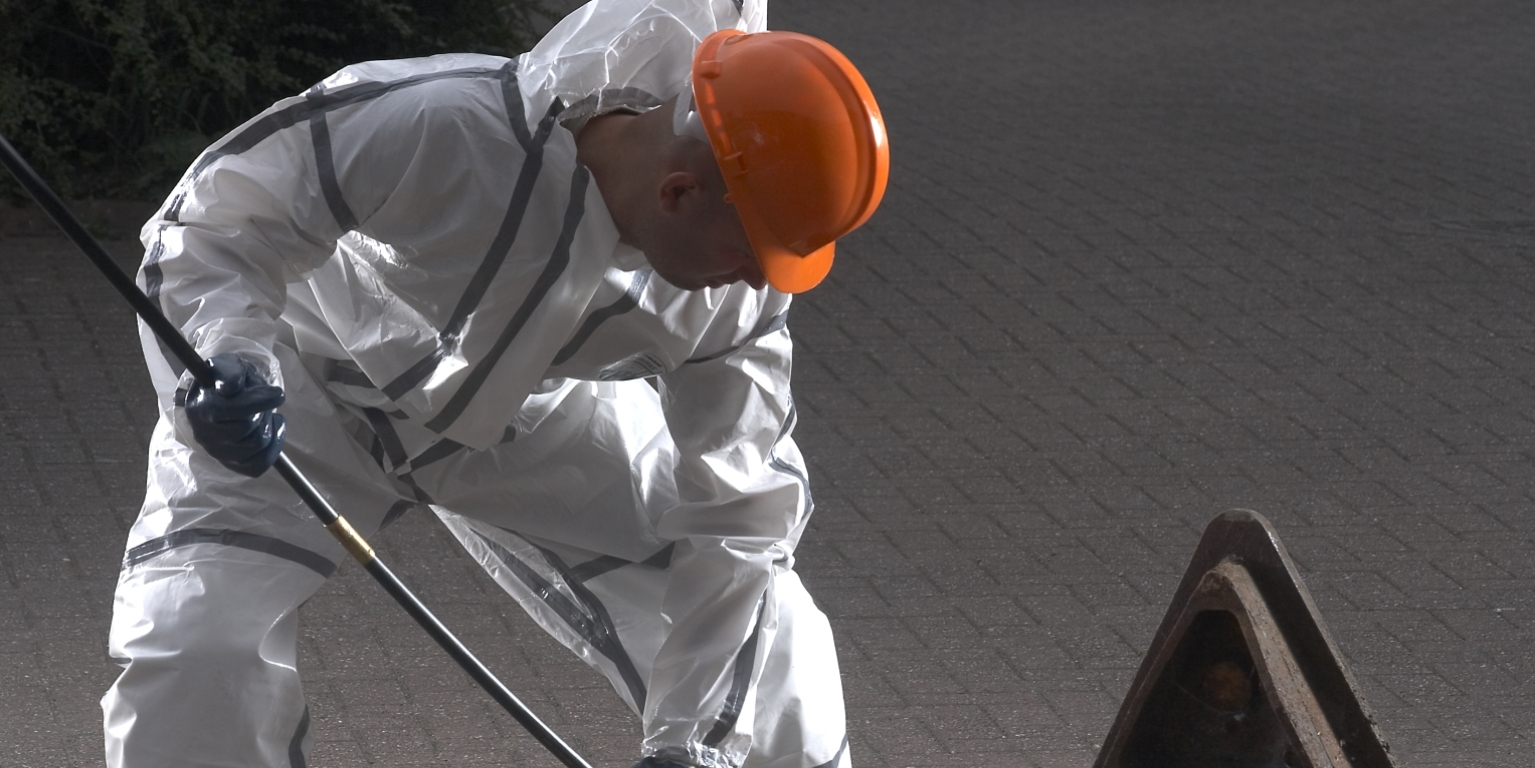
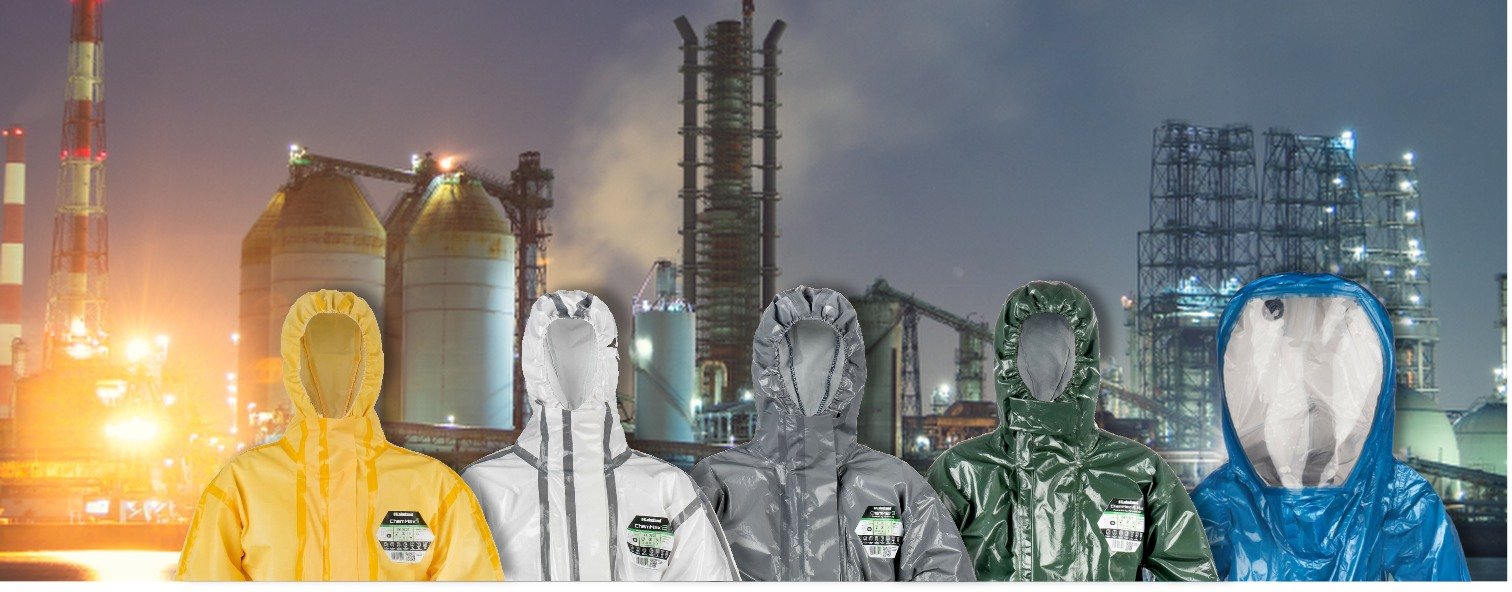

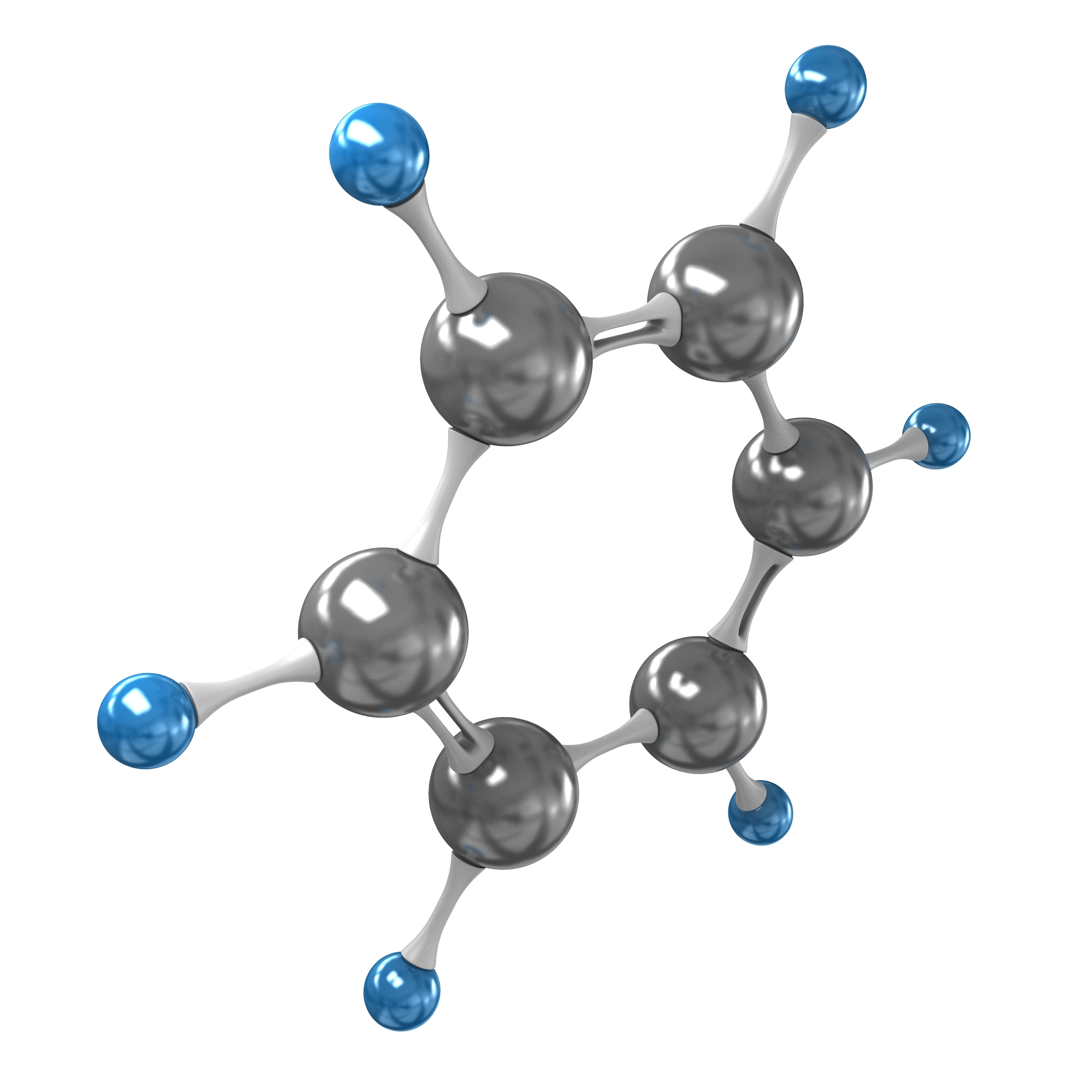
 Effectiveness of penetration resistance is defined by the construction and design of the suit and how effectively it coordinates with other PPE such as face-mask, gloves, and boots. It is therefor, garment DESIGN and FEATURES that ensure protection against PENETRATION through possible holes in the PPE ensemble.
Effectiveness of penetration resistance is defined by the construction and design of the suit and how effectively it coordinates with other PPE such as face-mask, gloves, and boots. It is therefor, garment DESIGN and FEATURES that ensure protection against PENETRATION through possible holes in the PPE ensemble.
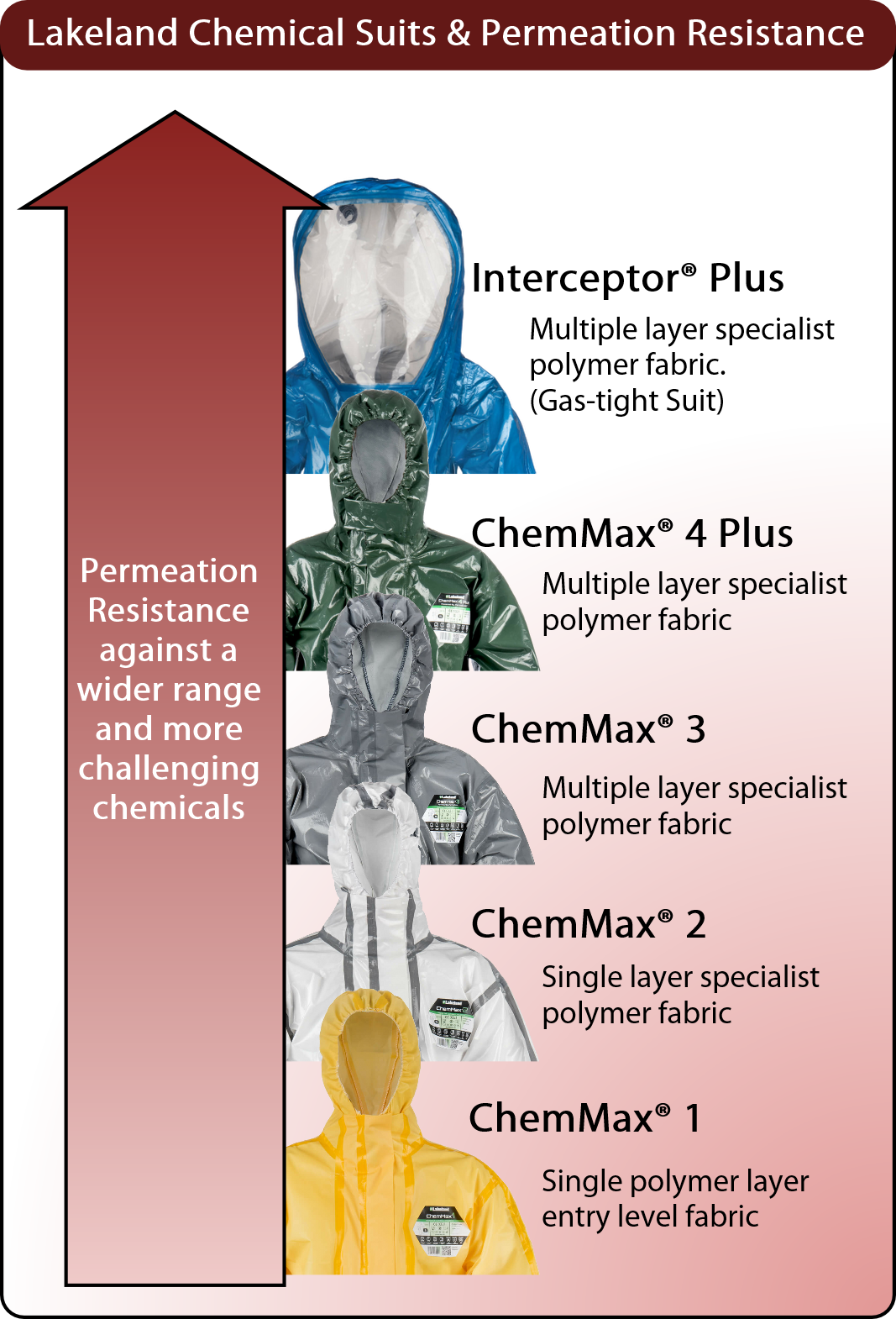


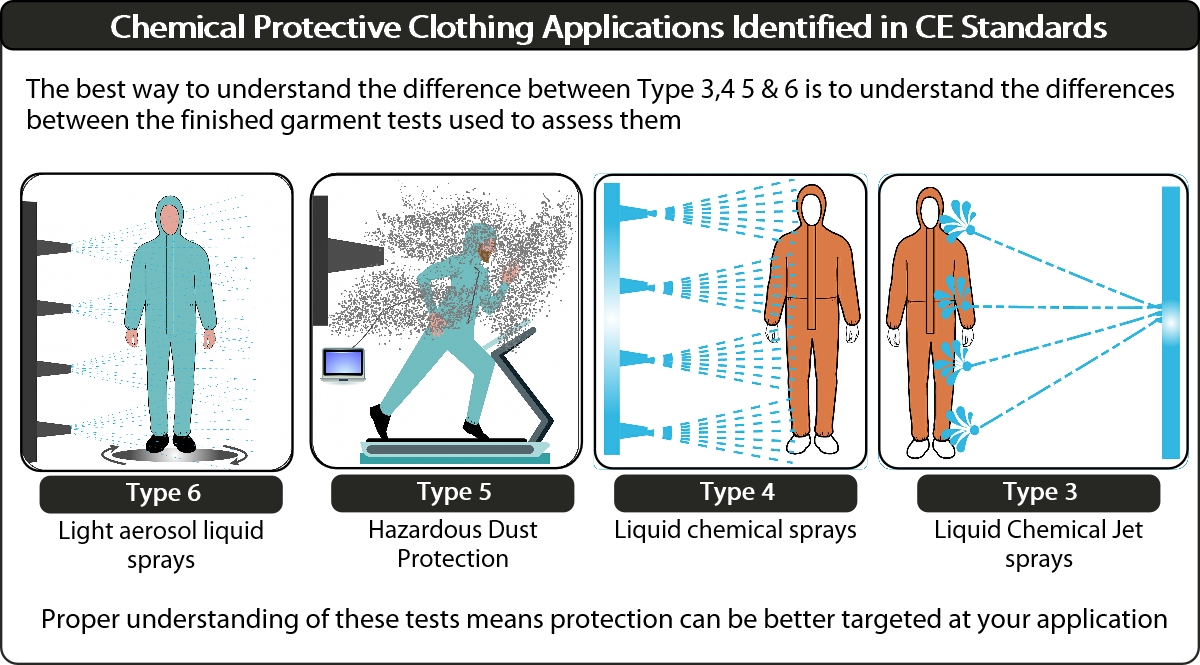

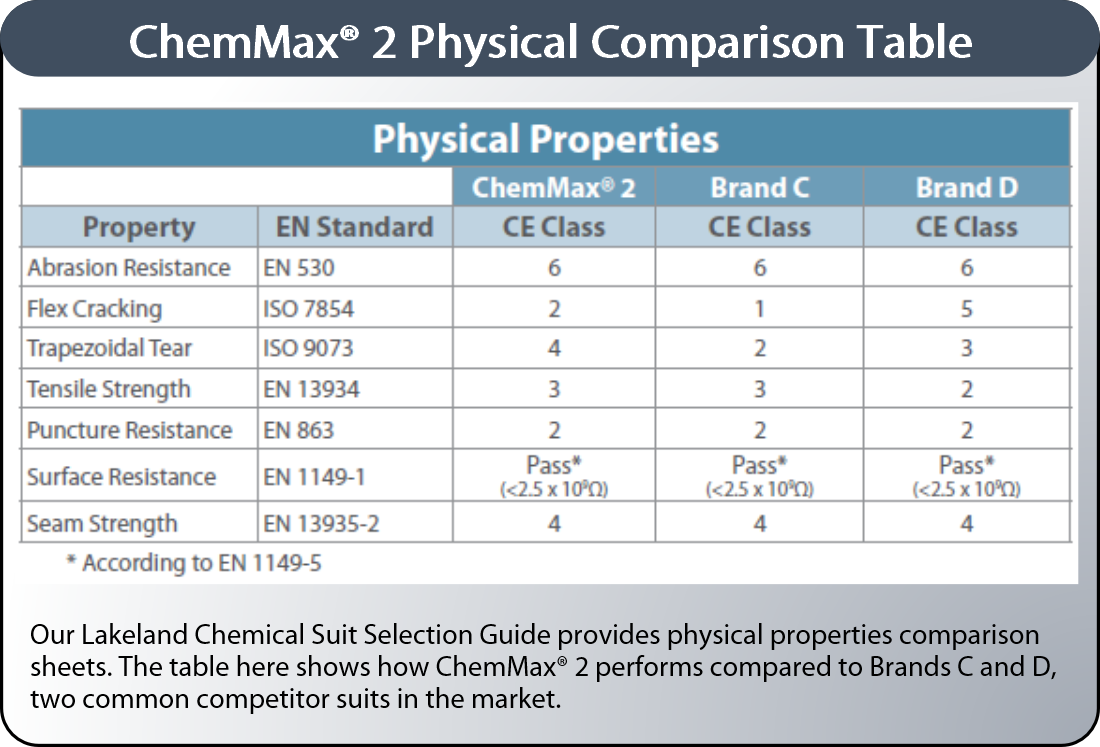 Lakeland ChemMax® clothing uses fabrics specifically designed and selected to optimize the combination of strength, weight, and flexibility (both of which also
Lakeland ChemMax® clothing uses fabrics specifically designed and selected to optimize the combination of strength, weight, and flexibility (both of which also 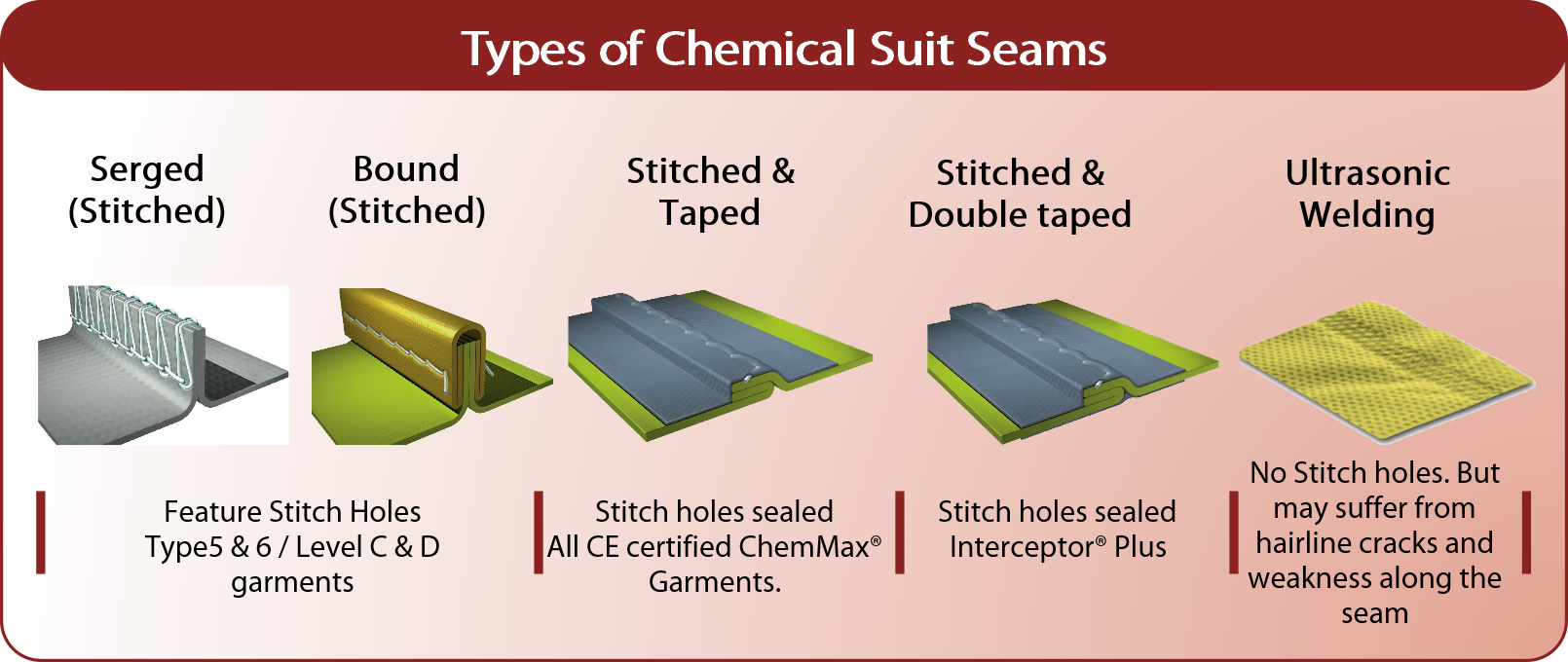

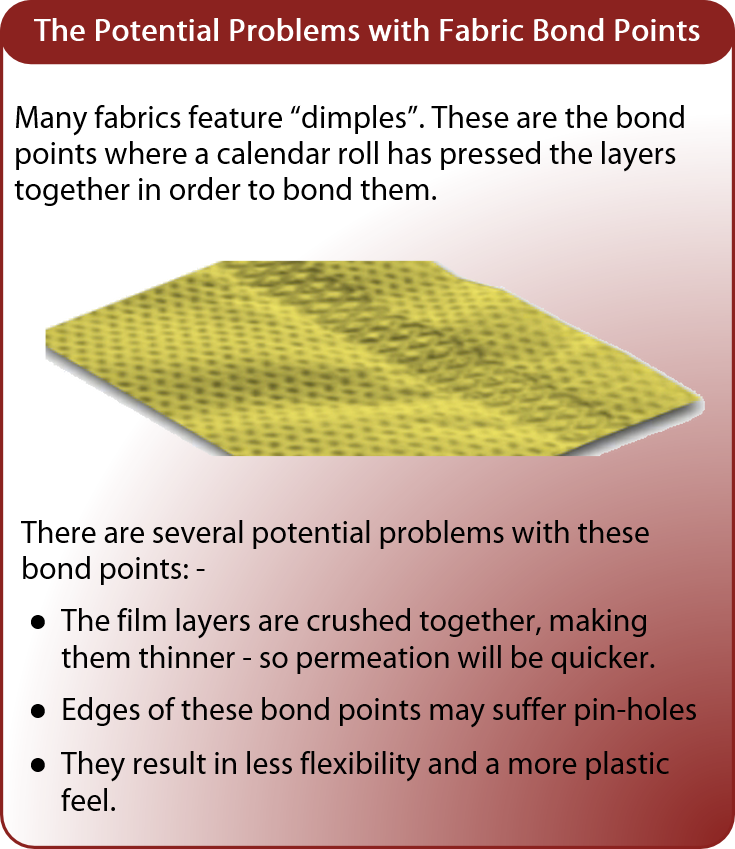 All ChemMax® garment fabrics are developed to combine lightness and flexibility and are often notably less stiff and plastic-feeling than many garments in the market. In addition, multi-layer ChemMax® 3, 4, Plus, and Interceptor Plus fabrics are constructed using a “co-extrusion method.” Where most fabrics consist of separate layers bonded together using adhesive or welding, these ChemMax® fabrics are extruded and bonded in one operation, resulting in a stronger, smoother, and more flexible finish.
All ChemMax® garment fabrics are developed to combine lightness and flexibility and are often notably less stiff and plastic-feeling than many garments in the market. In addition, multi-layer ChemMax® 3, 4, Plus, and Interceptor Plus fabrics are constructed using a “co-extrusion method.” Where most fabrics consist of separate layers bonded together using adhesive or welding, these ChemMax® fabrics are extruded and bonded in one operation, resulting in a stronger, smoother, and more flexible finish.